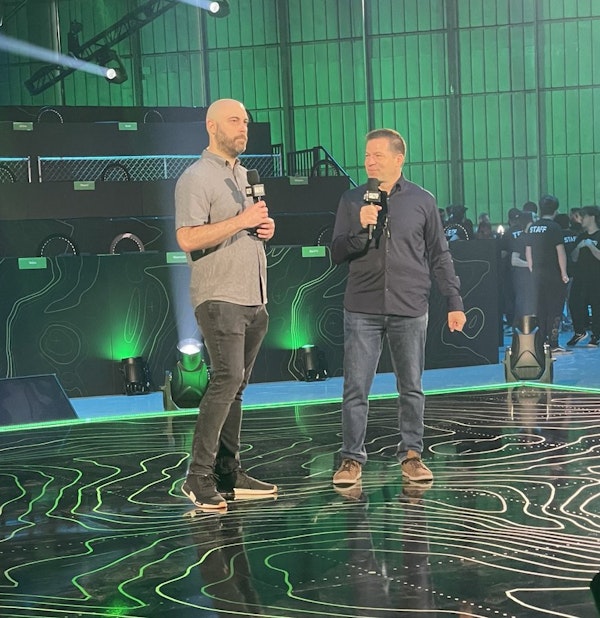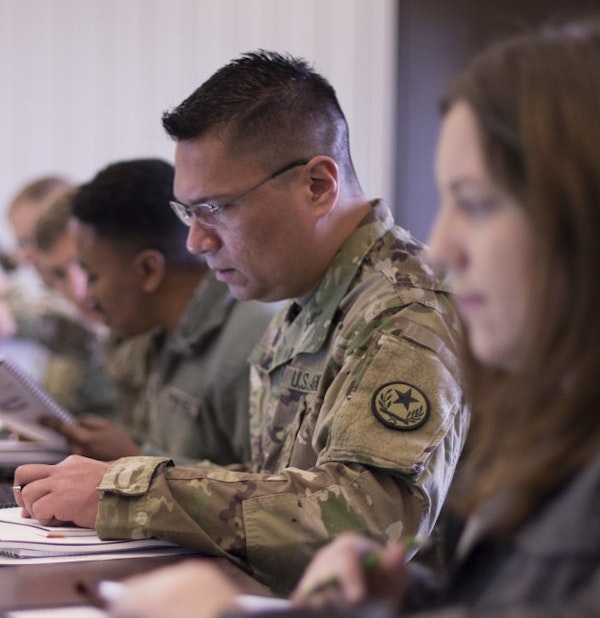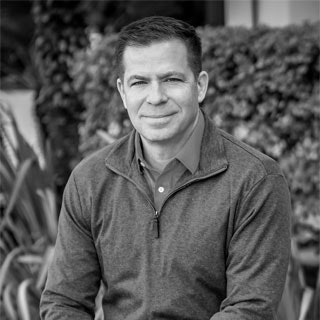Veterans are Qualified for Civilian Medical Jobs. Employ Them.
Many veterans return from their service having been trained as medical specialists. Their expertise could help fill the shortages in America’s health care system, but too often their skills are not put to use. Governors and state lawmakers, among others, can help correct this oversight with policies that make it easier for qualified veterans to transition into civilian care.
 Dan Goldenberg, right, attending Call of Duty NEXT to announce the Call of Duty Endowment. (Photo courtesy of Twitter)
Dan Goldenberg, right, attending Call of Duty NEXT to announce the Call of Duty Endowment. (Photo courtesy of Twitter)
Dan Goldenberg is Executive Director of Call of Duty Endowment, the largest philanthropic funder of veteran employment. A retired Navy Captain, Goldenberg has 27 years of active and reserve military duty. The Naval Academy graduate spoke with Mary Moore Hamrick, the Bush Institute’s Don Evans Family Managing Director of Domestic Policy, about the challenges veterans trained as medical specialists face in securing employment in the field of civilian health care. He also discusses how lessons learned from helping military medics move into the civilian medical world can be applied to other careers.
A portion of this interview is included in the video above, along with the edited excerpt below.
What advice do you give governors and state legislators to open up opportunities for trained veterans to serve as civilian medical professionals and help solve our healthcare jobs crisis?
An emergency medical technician (EMT) is a great place to start because it’s simple. It’s a no-brainer, and six states are currently doing it right. Alaska, Missouri, Arkansas, Kentucky, North Carolina, and Florida are helping qualified veterans become civilian EMTs. Governors and legislators should look at these states as models.
This is not a red-state/ blue-state issue. This is an American issue. And it’s one that’s eminently solvable.
We have a whole study on this at callofdutyendowment.org/medics. Within the study, there’s a Google sheet that lists specific information for every state and territory, who’s responsible, who the legislative or regulatory authority is, their contact information, and state-level recommendations on how they can improve.
Look to those six states listed for examples. This is not a red-state/ blue-state issue. This is an American issue. And it’s one that’s eminently solvable. There’s been a lack of understanding of the value of military medical training and experience among the civilian health care community. That needs to change.
Can anything be done at the federal level?
Surprisingly, that’s less than we thought. When we first looked at the federal level, we thought there’d be a policy solution there, but it’s not clear that there is. The Army and Air Force have shown tremendous leadership in requiring all the graduates of their basic level of medic or Air Force medical-tech training.
By the way, the Navy, Air Force, and Army all train together. They go to the same school, but the Army and Air Force require graduates to take the civilian test to get their National Registry of Emergency Medical Technicians’ certification. They make them have that ticket. All the veteran has to do is keep the credential current.
The Navy does not require this. The Navy’s view is they send a lot of their people to work in clinics and hospitals. To their mind, it’s not as applicable. I think it’s a mistake, and I’d love to see the Navy do exactly what the Army and Air Force have done. This will require a Department of Defense-level change.
But until we allow national-level licensure, which wouldn’t be a bad idea, it’s not clear what federal legislative policy is needed. The solution lies at the state level.
 The VA provides internships for transitioning service members (Photo courtesy of Twitter)
The VA provides internships for transitioning service members (Photo courtesy of Twitter)
Is there anything that health care professionals who oversee this credentialing process can do to help?
Yes, there’s so much. We’re having conversations with a number of states about this. It would help to have an extra push from industry to say, “Look, this is a great talent source. We’re making it difficult for us to hire them. This needs to change.”
There’s no cost to do this, and there are no partisan issues. You’re putting vets to work in jobs they want to work in that are suitable to the community. We know that 95% of post-9/11 service members want to continue serving in their communities when they leave the military. What better way than to do this?
Organizations like hospital chains and ambulance companies could help by being vocal with their state legislators and letting them know this is an easy problem to solve. Our study has very specific recommendations. There are models of how to do this right. They need to get involved. It’ll help them solve a labor issue and they’re not going to find much resistance.
We know that 95% of post-9/11 service members want to continue serving in their communities when they leave the military. What better way than to do this?
What we suffer from in state legislatures is the lack of knowledge. Health care professionals can educate legislators.
Are there any lessons learned from placing veterans in medical jobs that could be applied to other fields?
Yes. The Army does a great job publishing data each year through their Soldier for Life program. Their data shows most unemployed military occupational specialties. It’s shocking when you hold that up to the light with the needs in our society. Some of the most unemployed Army veterans are quartermasters, who deal with supplies. We’ve had a supply chain problem in this country for the last three years, yet it’s one of the most unemployed military occupational specialties.
We also know the country has a shortage of truck drivers. The Army has taken some good measures to ensure truck drivers have a commercial driver’s license when they leave the military. That wasn’t the case all the time, but that’s getting fixed.
A lot of former military truck drivers could drive a rig through the Khyber Pass, but they couldn’t drive it on I-10 because the Army didn’t teach them one thing that is really necessary: They had to be able to back up a rig to a loading dock by themselves.
If you can work on a Humvee, or an M1A1 tank, you should be able to work on a Honda, right? You’d think that would be possible. But it’s more challenging than it needs to be.
In the Army, they teach you to do that with a safety observer. In the commercial sector, there’s no safety observer. You have to be able to do that by yourself. If you can’t, you can’t get a commercial driver’s license. Barriers like that are being overcome.
One of our grantees started a program with Swift Transportation, the largest trucking company in America. They created backup driving scholarships, where veterans could fill that gap in knowledge. By fixing that one little thing, they placed 3,000 veterans in trucking jobs in the first year.
There are other fields, such as mechanics, where some states require their own licensure. You can imagine the environments that military mechanics have to work in are much more demanding than in the civilian sector.
If you can work on a Humvee, or an M1A1 tank, you should be able to work on a Honda, right? You’d think that would be possible. But it’s more challenging than it needs to be.
These are some of the fields in which there’s a lot more opportunity to do better.
The Catalyst believes that ideas matter. We aim to stimulate debate on the most important issues of the day, featuring a range of arguments that are constructive, high-minded, and share our core values of freedom, opportunity, accountability, and compassion. To that end, we seek out ideas that may challenge us, and the authors’ views presented here are their own; The Catalyst does not endorse any particular policy, politician, or party.


